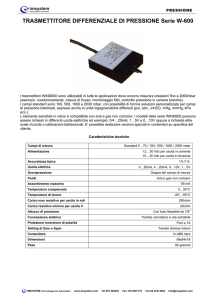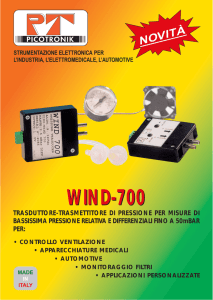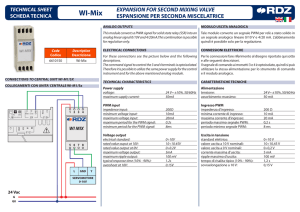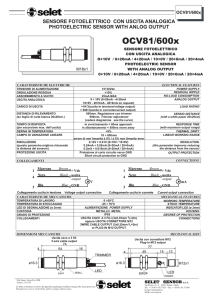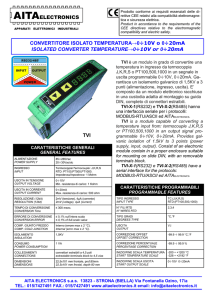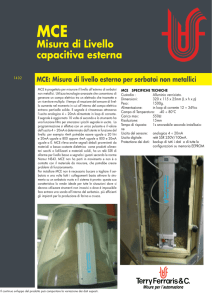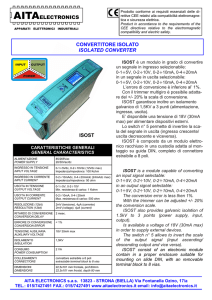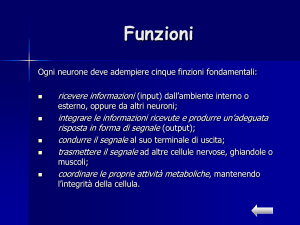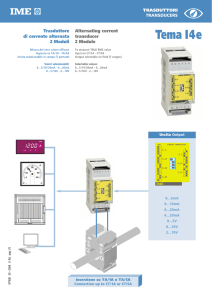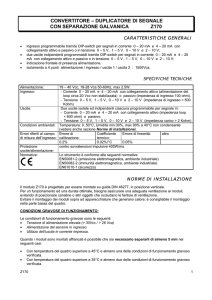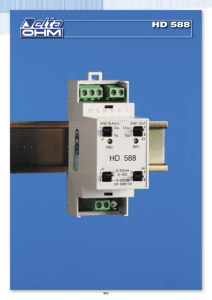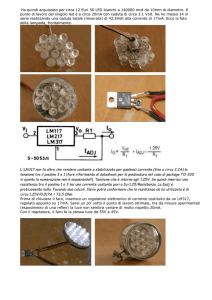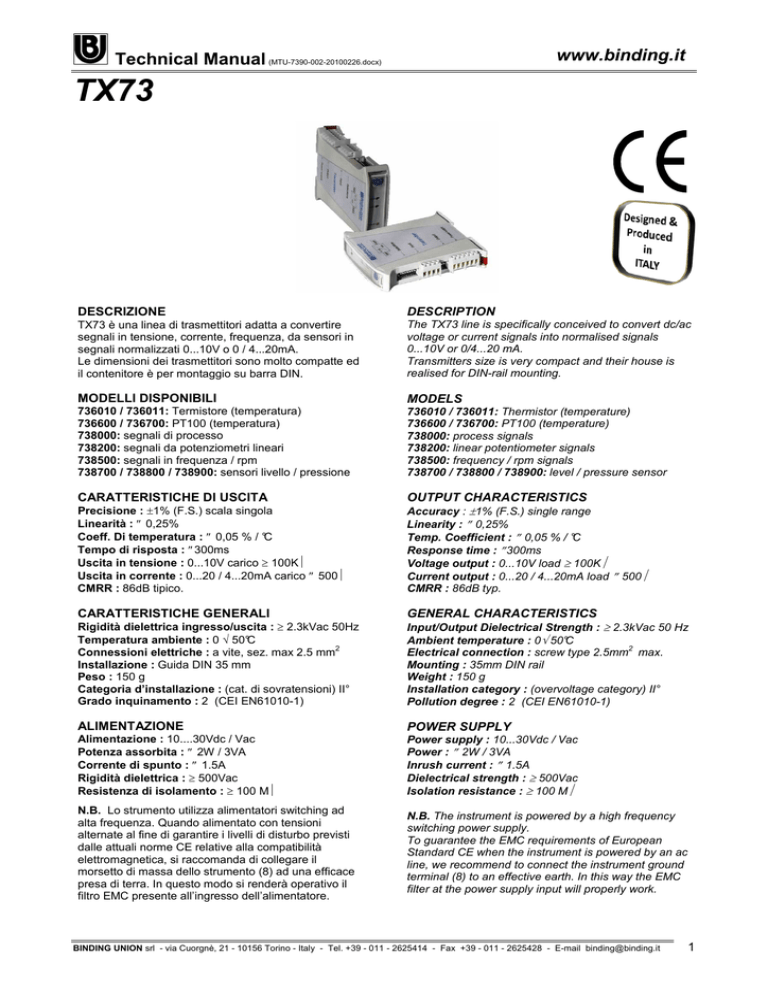
www.binding.it
Technical Manual (MTU-7390-002-20100226.docx)
TX73
DESCRIZIONE
DESCRIPTION
TX73 è una linea di trasmettitori adatta a convertire
segnali in tensione, corrente, frequenza, da sensori in
segnali normalizzati 0...10V o 0 / 4...20mA.
Le dimensioni dei trasmettitori sono molto compatte ed
il contenitore è per montaggio su barra DIN.
The TX73 line is specifically conceived to convert dc/ac
voltage or current signals into normalised signals
0...10V or 0/4...20 mA.
Transmitters size is very compact and their house is
realised for DIN-rail mounting.
MODELLI DISPONIBILI
MODELS
736010 / 736011: Termistore (temperatura)
736600 / 736700: PT100 (temperatura)
738000: segnali di processo
738200: segnali da potenziometri lineari
738500: segnali in frequenza / rpm
738700 / 738800 / 738900: sensori livello / pressione
736010 / 736011: Thermistor (temperature)
736600 / 736700: PT100 (temperature)
738000: process signals
738200: linear potentiometer signals
738500: frequency / rpm signals
738700 / 738800 / 738900: level / pressure sensor
CARATTERISTICHE DI USCITA
OUTPUT CHARACTERISTICS
Accuracy : ±1% (F.S.) single range
Linearity : ≤ 0,25%
Temp. Coefficient : ≤ 0,05 % / °C
Response time : ≤300ms
Voltage output : 0...10V load ≥ 100KΩ
Precisione : ±1% (F.S.) scala singola
Linearità : ≤ 0,25%
Coeff. Di temperatura : ≤ 0,05 % / °C
Tempo di risposta : ≤300ms
Uscita in tensione : 0...10V carico ≥ 100KΩ
Uscita in corrente : 0...20 / 4...20mA carico ≤ 500Ω
CMRR : 86dB tipico.
CARATTERISTICHE GENERALI
Rigidità dielettrica ingresso/uscita : ≥ 2.3kVac 50Hz
Temperatura ambiente : 0 ÷ 50°C
2
Connessioni elettriche : a vite, sez. max 2.5 mm
Installazione : Guida DIN 35 mm
Peso : 150 g
Categoria d’installazione : (cat. di sovratensioni) II°
Grado inquinamento : 2 (CEI EN61010-1)
Current output : 0...20 / 4...20mA load ≤ 500Ω
CMRR : 86dB typ.
GENERAL CHARACTERISTICS
Input/Output Dielectrical Strength : ≥ 2.3kVac 50 Hz
Ambient temperature : 0÷ 50°C
2
Electrical connection : screw type 2.5mm max.
Mounting : 35mm DIN rail
Weight : 150 g
Installation category : (overvoltage category) II°
Pollution degree : 2 (CEI EN61010-1)
ALIMENTAZIONE
POWER SUPPLY
Alimentazione : 10....30Vdc / Vac
Potenza assorbita : ≤ 2W / 3VA
Corrente di spunto : ≤ 1.5A
Rigidità dielettrica : ≥ 500Vac
Resistenza di isolamento : ≥ 100 MΩ
Power supply : 10...30Vdc / Vac
Power : ≤ 2W / 3VA
Inrush current : ≤ 1.5A
Dielectrical strength : ≥ 500Vac
Isolation resistance : ≥ 100 MΩ
N.B. Lo strumento utilizza alimentatori switching ad
alta frequenza. Quando alimentato con tensioni
alternate al fine di garantire i livelli di disturbo previsti
dalle attuali norme CE relative alla compatibilità
elettromagnetica, si raccomanda di collegare il
morsetto di massa dello strumento (8) ad una efficace
presa di terra. In questo modo si renderà operativo il
filtro EMC presente all’ingresso dell’alimentatore.
N.B. The instrument is powered by a high frequency
switching power supply.
To guarantee the EMC requirements of European
Standard CE when the instrument is powered by an ac
line, we recommend to connect the instrument ground
terminal (8) to an effective earth. In this way the EMC
filter at the power supply input will properly work.
BINDING UNION srl - via Cuorgnè, 21 - 10156 Torino - Italy - Tel. +39 - 011 - 2625414 - Fax +39 - 011 - 2625428 - E-mail [email protected]
1
www.binding.it
Technical Manual (MTU-7390-002-20100226.docx)
TX 73
COLLEGAMENTI ELETTRICI
ELECTRICAL CONNECTIONS
OUTPUT
INPUT
POWER SUPPLY
Power
1 2
4 5 6 7
3
8 9 10
Zero
(+)
(-)
+
Span
-
EARTH
S1
1
4
PROGRAMMAZIONE INGRESSI
INPUT PROGRAMMING
Il TRANSMITTER 73 è costituito da una gamma di
modelli per diversi tipi di segnale, alcuni di questi
permettono interventi di configurazione degli ingressi.
Tutte le indicazioni necessarie sono fornite nelle pagine
specifiche dei diversi modelli.
TRANSMITTER 73 line includes several models to
process many different signals some of which can have
the input configuration programmable.
All necessary information are provided on the specific
model data sheet.
PROGRAMMAZIONE USCITE
OUTPUT PROGRAMMING
La programmazione delle uscite si effettua agendo sul
dip-switch S1, posizionato sul frontale del trasmettitore,
sotto i due trimmer. Vedi tabella sottostante. E’
possibile tuttavia ritoccare la taratura di zero e di fondo
scala (span) agendo sui trimmer frontali, dopo aver
atteso 10min. dall’accensione.
Uscita di default : 0...10V
Output programming can be performed by means of the
dip-switch S 1, located on the front side, below the two
trimmers See table below. However, it is possible to
trim the zero and span by adjusting the two front
trimmers, after 10min. of warm-up time.
Default output : 0...10V
S1
OUT
0...10V
0...20mA
4...20mA
1
ON
ON
OFF
2
OFF
OFF
ON
3
OFF
ON
ON
4
ON
OFF
OFF
S1
1
4...20mA
4
4
DIMENSIONI
ON
1
0...20mA
ON
ON
1
0...10V
4
120 mm
DIMENSIONS
100 mm
22,5 mm
BINDING UNION srl - via Cuorgnè, 21 - 10156 Torino - Italy - Tel. +39 - 011 - 2625414 - Fax +39 - 011 - 2625428 - E-mail [email protected]
2
www.binding.it
Technical Manual (MTU-7390-002-20100226.docx)
736010 / 736011 – Termistori / Termistors
FUNZIONI
FUNCTIONS
Transmitter 736010 e 736011 convertono e isolano i
segnali provenienti da sensori di temperatura per fluidi
vari tipo Termistore in segnali normalizzati 0...10V o
0 / 4...20mA.
736010 and 736011 Transmitters convert and isolate
signals coming from Thermistor temperature sensor
into normalised signals 0...10V or 0 / 4...20mA
COLLEGAMENTO INGRESSI
INPUT CONNECTIONS
Ingresso segnale : morsetti 5 e 7 (-)
Input signal: terminal boards 5 and 7 (-)
OUTPUT
INPUT POWER SUPPLY
1 2 3
Modello
Models
736010
736011
4 5
Scala di misura
Measuring range
40...120°C / 105...250°F
50...150°C / 120...300°F
6
7
8 9 10
Scala di resistenza
Resistance range
287.4...22.7 Ω
323.2...18.6 Ω
CONFIGURAZIONE DEL RANGE
RANGE PROGRAMMING
Se necessario verificare la taratura agire come segue (i
trasmettitori sono comunque forniti già tarati con
apparecchiature campione) :
a) verificare che il segnale in uscita sia quello voluto o
selezionare come indicato a pag.2, alimentare lo
strumento e attendere 10 min.
b) fornire il segnale minimo es. 40°C = 287,40 Ω e
verificare il segnale di uscita (0V, 0mA, 4mA) se
necessario aggiustare con il trimmer di zero.
c) fornire il segnale massimo es. 120°C = 22,7 Ω e
verificare il segnale di uscita (10V, 20mA) se
necessario aggiustare con il trimmer di span.
d) Attendere 2 min. e ripetere i punti b e c per
verificare la correttezza della taratura.
If necessary, check the trimming as follows :
a) check the output signal is as required; otherwise
follow the instructions shown on page 2, power up
the instrument and wait for 10 min.
b) provide the minimum input signal e.g. 40°C =
287.40Ω and adjust the output signal (0V, 0mA,
4mA) with the zero trimmer.
c) provide the maximum signal e.g. 120°C = 22.7 Ω
and adjust the output signal (10V, 20mA) with the
span trimmer.
d) wait for 2 min. and repeat the steps b and c to verify
the correctness of the fine-tuning.
Reference values for temperature / resistance
I valori di riferimento per la conversione
convertion are the following:
temperatura/resistenza sono i seguenti:
modello 736010 : 40°C (105°F) = 287.4 Ω - 90°C (195°F) = 51.2 Ω - 120°C (250°F) = 22.7 Ω
modello 736011 : 50°C (120°F) = 323.2 Ω - 120°C (250°F) = 36.8 Ω - 150°C (300°F) = 18.6 Ω
BINDING UNION srl - via Cuorgnè, 21 - 10156 Torino - Italy - Tel. +39 - 011 - 2625414 - Fax +39 - 011 - 2625428 - E-mail [email protected]
3
www.binding.it
Technical Manual (MTU-7390-002-20100226.docx)
736600 / 736700 - Sensori PT100 / PT100 Sensors
FUNZIONI
FUNCTIONS
Transmitter 736600 e 736700 convertono e isolano i
segnali provenienti da sensori di temperatura tipo
PT100 (secondo la tabella IEC751) in segnali
normalizzati 0...10V o 0 / 4...20mA.
736600 and 736700 Transmitters convert and isolate
signals coming from PT100 (table IEC751) temperature
sensors into normalised signals 0...10V or 0 / 4...20mA
COLLEGAMENTO INGRESSI
INPUT CONNECTIONS
Ingresso segnale : morsetti 4 (PT100) (bianco)
5 (PT100) (rosso) - 7 (SENSE) (rosso)
Input signal: terminal boards 4 (PT100) (white)
5 (PT100) (red) - 7 (SENSE) (red)
OUTPUT
INPUT POWER SUPPLY
1 2 3
4
5 6 7
8 9 10
J1
A B C
CONFIGURAZIONE DEL RANGE
RANGE PROGRAMMING
736600 and 736700 Transmitters have three
I Transmitter 736600 e 736700 dispongono di tre scale
temperature ranges on their inputs trimmed to obtain
di temperatura in ingresso pretarate per ottenere la
the output maximum resolution.
massima risoluzione del segnale di uscita.
736600 = 0...50°C / 0...100°C / 0...200°C
736700 = 0...200°C / 0...400°C / 0...800°C
Default scales are those in bold.
Le scale in neretto sono quelle programmate di serie.
To change the input temperature range move the
Per cambiare la scala di temperatura in ingresso
spostare il ponticello J1 come indicato nella tabella
jumper J1 as shown in the following table.
sottostante.
Modello
736600
736700
Posizione J1 / J1 position
A - B = on
0...50°C
0...200°C
Se necessario verificare la taratura in seguito ad un
cambio scala, agire come segue (i trasmettitori sono
comunque forniti già tarati con apparecchiature
campione) :
e) verificare che il segnale in uscita sia quello voluto o
selezionare come indicato a pag.2, alimentare lo
strumento e attendere 10 min.
f) fornire il segnale di 0°C = 100,00 Ω e aggiustare il
segnale di uscita (0V, 0mA, 4mA) con il trimmer di
zero.
g) fornire il segnale massimo es. 200°C = 175,86 Ω e
aggiustare il segnale di uscita (10V, 20mA) con il
trimmer di span.
h) Attendere 2 min. e ripetere i punti b e c per
verificare la correttezza della taratura.
Nel caso non si disponga della tabella IEC751 prendere
a riferimento i seguenti valori:
0°C = 100,00 Ω - 50°C = 119,40 Ω 100°C = 138,51 Ω - 200°C = 175,86 Ω
400°C = 247,09 Ω - 800°C = 375,70 Ω
B - C = on
0...100°C
0...400°C
A - B - C = off
0...200°C
0...800°C
After a changing of scale, if necessary, check the
trimming as follows :
e) check that the output signal is as you want other
wise follow the instructions shown on page 2, power
up the instrument and wait 10 min.
f) provide the input signal 0°C = 100.00 Ω and adjust
the output signal (0V, 0mA, 4mA) with the zero
trimmer.
g) provide the maximum signal e.g. 200°C = 175.86 Ω
and adjust the output signal (10V, 20mA) with the
span trimmer.
h) wait 2 min. and repeat the steps b and c to verify
the correctness of the procedure.
In case of you do not have the table IEC751 take as an
example the following values :
0°C = 100.00 Ω - 50°C = 119.40 Ω
100°C = 138.51 Ω - 200°C = 175.86 Ω
400°C = 247.09 Ω - 800°C = 375.70 Ω
BINDING UNION srl - via Cuorgnè, 21 - 10156 Torino - Italy - Tel. +39 - 011 - 2625414 - Fax +39 - 011 - 2625428 - E-mail [email protected]
4
www.binding.it
Technical Manual (MTU-7390-002-20100226.docx)
738000 - Segnali di processo / Process signals
FUNZIONI
FUNCTIONS
Transmitter 738000 converte e / o isola i più diffusi
segnali normalizzati 0...10V o 0 / 4...20mA, in altri
segnali normalizzati 0...10V o 0 / 4...20mA.
738000 Transmitter is specifically conceived to convert
and / or isolate normalised process signal into
normalised signals 0...10V or 0/4...20 mA.
CARATTERISTICHE DI INGRESSO
INPUT CHARACTERISTICS
Impedenza d’ingresso : 0…10V = 500 kΩ
0/4…20mA= 10 Ω
Input impedance : 0...10V = 500 kΩ
0/4...20mA = 10 Ω
COLLEGAMENTO INGRESSI
INPUT CONNECTIONS
Ingresso 0...10V : morsetti 5 (+) e 7 (-)
Ingresso 0 / 4...20mA : morsetti 6 (+) e 7 (-)
Input 0...10V : terminals 5 (+) and 7 (-)
Input 0 / 4...20mA : terminals 6 (+) and 7 (-)
OUTPUT
1 2 3 1
INPUT POWER SUPPLY
SW1
6
T1 T3 T2
4 5 6
7
8
9 10
CONFIGURAZIONE DEL RANGE
RANGE PROGRAMMING
La selezione del tipo di segnale da misurare si effettua
tramite 6 ponticelli come indicato in tabella.
Signal type selection can be made by using 6 jumpers
as shown in the table.
SEGNALI DI PROCESSO PROCESS SIGNALS
Posizione ponticelli : SW1
Jumpers position : SW1
1-3-5 ON
2-3-5 ON
2-4-5 ON
5 ON
5 OFF
2-4-6 OFF
1-4-6 OFF
1-3-6 OFF
6 OFF
6 ON
Dopo avere effettuato la selezione del tipo di segnale
ritoccare la taratura dello zero e dello span nel modo
seguente:
a) Alimentare il trasmettitore.
b) Verificare che il segnale in uscita sia corretto
diversamente intervenire come indicato a pag. 2 alla
voce “PROGRAMMAZIONE USCITE”
c) Applicare il segnale minimo (0V, 0mA, 4mA) e
ruotare T2 per ottenere in uscita 0V, 0mA, 4mA. Per
compensare un eventuale scostamento del valore
minimo teorico inserire la regolazione di offset
programmando i ponticelli 5 e 6 di SW1 secondo la
precedente tabella.
Ruotare T3 fino alla correzione del segnale.
d) Applicare il valore massimo (10V, 20mA) e ruotare
T1 fino all’ottenimento del segnale di uscita.
e) Attendere 2 minuti e ripetere i punti c) e d) per
verificare la correttezza della taratura.
Funzione
Function
0...10V input
0...20mA input
4...20mA input
000 offset
offset attivo / active offset
After having selected the range, adjust the zero and the
span according to the following procedure :
a) Power up the transmitter.
b) Check for the correctness of the output signal,
otherwise behave as shown on page 2 for the
“OUTPUT PROGRAMMING”.
c) Connect the input minimum signal (0V, 0mA, 4mA)
and turn T2 to obtain an output of 0V, 0mA, 4mA.
To compensate for a possible error on the
theoretical minimum value activate the offset
regulation by programming SW1 as shown in the
previous table. Turn T3 to adjust the output
minimum signal.
d) Apply the input maximum signal (10V, 20mA) and
turn T1 till the required output signal is reached.
e) Wait for at least 2 minutes and recheck the points c)
and d) to verify the setting.
BINDING UNION srl - via Cuorgnè, 21 - 10156 Torino - Italy - Tel. +39 - 011 - 2625414 - Fax +39 - 011 - 2625428 - E-mail [email protected]
5
www.binding.it
Technical Manual (MTU-7390-002-20100226.docx)
738000 - Segnali di processo / Process signals
APPLICAZIONI SPECIFICHE
SPECIFIC APPLICATIONS
Transmitter 738000 ha molte possibilità di applicazione,
una di queste è la misura di livello con l’abbinamento a
sonde capacitive per serbatoi d’acqua:
Dopo aver installato la sonda secondo le specifiche del
costruttore collegarsi come da schema seguente.
738000 Transmitter has many application possibilities,
one of these is the level measurement of water tanks
when used with capacitance probes:
After having fixed the probe according to the supplier
specifications make connections as shown in the
following scheme.
OUTPUT
1 2 3 1
INPUT POWER SUPPLY
SW1
6
T1 T3 T2
4 5 6
7
8
9 10
P1
A
12 / 24V
a) Verificare che il segnale in uscita sia corretto o
intervenire come indicato a pag. 2 alla voce
“PROGRAMMAZIONE USCITE”
b) Riempire il serbatoio d’acqua e alimentare il
trasmettitore.
c) Tarare il segnale massimo trasmesso dalla sonda
(20mA) tramite P1 (raggiungibile tra le connessioni
della sonda) per avere l’uscita equivalente a PIENO
d) Vuotare il serbatoio facendo scendere il livello
dell’acqua sotto il sensore (A).
e) Regolare l’uscita per indicare “VUOTO” (0V, 0mA,
4mA) con il trimmer T2 (Se l’escursione di T2 non
fosse sufficiente spostare il ponticello dalla pos. 5
alla pos. 6 e ruotare T3 fino alla correzione del
segnale in uscita).
a) Check for the correctness of the output signal,
otherwise behave as shown on page 2 for the
“OUTPUT PROGRAMMING”.
b) Fill the water tank and power up the transmitter.
c) Adjust the probe output signal (20mA) by using P1,
(available between the probe output connections) to
obtain at the transmitter output the equivalent FULL
scale signal.
d) Discharge the tank till the water level is below the
probe (A).
e) Trim the output signal to the minimum level (0V,
0mA, 4mA) by using T2 on the transmitter. If the T2
regulation is not enough insert the offset adjust
(jumpers 5 and 6 ) and turn T3 to correct the output
signal.
BINDING UNION srl - via Cuorgnè, 21 - 10156 Torino - Italy - Tel. +39 - 011 - 2625414 - Fax +39 - 011 - 2625428 - E-mail [email protected]
6
www.binding.it
Technical Manual (MTU-7390-002-20100226.docx)
738200 - Segnali potenziometro / Potentiometer signals
FUNZIONI
FUNCTIONS
Transmitter 738200 converte e isola i segnali
provenienti da potenziometri lineari con valore
compreso tra 1...50kΩ, in segnali normalizzati 0...10V o
0 / 4...20mA.
738200 Transmitter converts and isolates signals
coming from linear potentiometers with value included
between 1...50KΩ, on standard signals 0...10V or
0 / 4...20mA.
COLLEGAMENTO INGRESSI
INPUT CONNECTIONS
Ingresso da potenziometro : morsetti 5 (+) - 6 (IN) 7 (-)
Potentiometer input : terminals 5 (+) - 6 (IN) - 7 (-)
Pin 5 supplies the potentiometer with a 2.5V reference
voltage.
Al morsetto 5 è presente la tensione di riferimento di
2,5V per alimentare il potenziometro.
OUTPUT
1 2
3 1
INPUT POWER SUPPLY
SW1
6
T1 T3 T2
4 5
6 7
8
9 10
CONFIGURAZIONE DEL RANGE
RANGE PROGRAMMING
La selezione del tipo di segnale da misurare si effettua
tramite SW1 come indicato in tabella.
Signal type selection can be made by using SW1 as
shown in the table.
SEGNALI DI PROCESSO PROCESS SIGNALS
Posizione ponticelli : SW1
Jumpers position : SW1
2-3-5 ON
5 ON
5 OFF
1-4-6 OFF
6 OFF
6 ON
Dopo avere predisposto la funzione di ingresso per
Potenziometro, ritoccare la taratura dello zero e dello
span nel modo seguente:
a) Alimentare il trasmettitore.
b) Verificare che il segnale in uscita sia corretto
diversamente intervenire come indicato a pag. 2 alla
voce “PROGRAMMAZIONE USCITE”
c) Azzerare il potenziometro e ruotare T2 per ottenere
in uscita 0V, 0mA, 4mA. Per compensare un
eventuale scostamento del valore minimo teorico
inserire la regolazione di offset programmando i
ponticelli 5 e 6 di SW1 secondo la precedente
tabella.
Ruotare T3 fino alla correzione del segnale.
d) Portare il potenziometro a fine corsa e ruotare T1
fino all’ottenimento del segnale di uscita.
e) Attendere 2 minuti e ripetere i punti c) e d) per
verificare la correttezza della taratura.
Funzione
Function
Potentiometer input
000 offset
offset attivo / active offset
After having set the input function for Potentiometer,
adjust the zero and the span according to the following
procedure :
a) Power up the transmitter.
b) Check for the correctness of the output signal,
otherwise behave as shown on page 2 for the
“OUTPUT PROGRAMMING”.
c) Set the potentiometer to zero and turn T2 to obtain
an output of 0V, 0mA, 4mA. To compensate for a
possible error on the theoretical minimum value
activate the offset regulation by programming SW1
as shown in the previous table. Turn T3 to adjust
the output minimum signal.
d) Set the potentiometer to its full scale and turn T1 till
the required output signal is reached.
e) Wait for at least 2 minutes and recheck the points c)
and d) to verify the setting.
BINDING UNION srl - via Cuorgnè, 21 - 10156 Torino - Italy - Tel. +39 - 011 - 2625414 - Fax +39 - 011 - 2625428 - E-mail [email protected]
7
www.binding.it
Technical Manual (MTU-7390-002-20100226.docx)
738500 - Frequenza e velocità / Frequency and rpm
FUNZIONI
FUNCTIONS
Transmitter 738500 converte e isola i segnali in
frequenza provenienti da sensori elettronici o dalla rete
in segnali normalizzati 0...10V o 0 / 4...20mA.
738500 Transmitter is specifically conceived to convert
and isolate frequency signals into normalised signals
0...10V or 0 / 4...20mA
COLLEGAMENTO INGRESSI
INPUT CONNECTIONS
Tensione alternata
Alternating voltage
: morsetti 4 (Hi) / 7 (Lo)
: terminals 4(Hi) / 7(Lo)
TTL / CMOS / Proximity
Sensori induttivi e di Hall
Pick-up / Open collector / PNP : morsetti 5 (Hi) / 7 (Lo)
TTL / CMOS / Proximity
Hall and inductive sensors
Pick-up / Open collector / PNP : terminals 5(Hi) / 7(Lo)
Encoder / Sonda ottica : morsetti 5(Hi)/ 6(aux +)/ 7(Lo)
Encoder / Optical probe : terminals 5(Hi)/ 6(aux)/ 7(Lo)
Giri motore: collegamento da terminale 1 della bobina
(motori benzina) - oppure da terminale W
dell’alternatore (motore diesel) al morsetto
5 (HI) ed il morsetto 7 (LO) al negativo
dell’alimentazione.
Engine Turns Number : terminal 1 ignition coil (Fuel
engine) - terminal W alternator
(Diesel engine) 5(HI) and terminal
7(LO) connected to the negative.
5
12 / 24V
HI
7
5
GND
HALL
SENSOR
7
5
HI
Proximity
Pick-up
6
AUX(+)
7
GND
Optical probe
Encoder
CARATTERISTICHE INGRESSO
INPUT SPECIFICATIONS
Campo di frequenza : 0...20 / 200 / 2000 Hz
20 kHz
Sensibilità ingressi
Tensione alternata
: 12...250 Vrms
TTL/CMOS
: 0...5 V ( soglia a 2,5V)
Pick-up
: 0...5 V ( soglia a 0,5Vp)
Proximity
: 0,5...10 Vpp
Impedenza ingresso
Tensione alternata
: ≥ 490 KΩ
Sonda ottica/Open collector/Proximity : ≥ 10 KΩ
CMOS/TTL/Pick-up
: ≥ 100 KΩ
Sovraccarico
Tensione alternata
: ≤ 1 KVrms
TTL/CMOS/Proximity/Pick-up : ≤ 50 Vdc
Alimentazione sensori
morsetti 6(+) e 7(-) : +5 Vdc 30 mA
Frequency range : 0...20 / 200 / 2000 Hz
20 kHz
Input sensitivity
Alternating voltage
: 12...250 Vrms
TTL/CMOS
: 0...5 V (2.5 V threshold)
Pick-up
: 0...5 V (0.5 Vp threshold)
Proximity
: 0.5...10 Vpp
Input impedance
Alternating voltage
: ≥ 490 KΩ
Optical Probe/Open collector/Proximity : ≥ 10 KΩ
CMOS/TTL/Pick-up : ≥ 100 KΩ
Overload
Alternating voltage
: ≤ 1 KVrms
TTL/CMOS/Proximity/Pick-up : ≤ 50 Vdc
Sensor power supply
terminals 6(+) and 7(-) : +5 Vdc 30 mA
SELEZIONE SCALA
SCALE SELECTION
La scala di default è 200 Hz. Se usato come
frequenzimetro, per cambiare il fondo scala è
necessario impostare il ponticello SW1 come indicato:
-Per fondo scala 20 Hz : 7-5-4-3-2-1 ON
-Per fondo scala 200 Hz : 8-5-4
ON
-Per fondo scala 2000 Hz : 9-7
ON
-Per fondo scala 20 kHz : 10
ON
Default scale is 200 Hz. Full scale can be modified by
operating the jumper SW1 as follows :
-20 Hz full scale
: 7-5-4-3-2-1 ON
-200 Hz full scale
: 8-5-4
ON
-2000 Hz full scale : 9-7
ON
-20 kHz full scale : 10
ON
SELEZIONE SENSORE
SENSOR SELECTION
Lo strumento viene fornito con configurazione standard
per ricevere segnali da Proximity, Sonde Ottiche,
sensori Open Collector, NPN. E’ possibile tuttavia
l’utilizzo con segnali diversi.
Programmare, i ponticelli SW2 come segue:
segnali da pick-up
: posizione 4 OFF e pos. 3 ON
segnali TTL / Encoder / PNP : posizione 4 e 3 OFF
tensione di rete
: posizione 4 e 3 OFF
config. standard
: posizione 4 ON e pos. 3 OFF
Instrument is delivered in default configuration to
receive signals from Proximity, Optical probes, Open
Collector sensors, NPN. It is anyway possible to
program the tachometer to accept different signals.
Set SW2 jumpers as follows:
pick-up signals
: position 4 OFF, pos. 3 ON
TTL signals / Encoder / PNP : position 4 and 3 OFF
alternating voltage : position 4 and 3 OFF
default condition
: position 4 ON, pos.3 OFF
ON = Jumper inserted - OFF = jumper not inserted
ON= ponticello inserito - OFF= ponticello disinserito
BINDING UNION srl - via Cuorgnè, 21 - 10156 Torino - Italy - Tel. +39 - 011 - 2625414 - Fax +39 - 011 - 2625428 - E-mail [email protected]
8
www.binding.it
Technical Manual (MTU-7390-002-20100226.docx)
738500 - Frequenza e velocità / Frequency and rpm
SW1
SW2
1
SW1
N
1
512
2
256
3
128
4
64
5
32
6
16
10
7
8
8
4
9
2
1
10
1
4
SW2
ON
1
2
3
4
Delay
10 sec.
Delay
1 sec.
Pick-up
mV∼
internal
Pull-up
CONFIGURAZIONE DEL RANGE
RANGE PROGRAMMING
Verificare che il segnale in uscita sia corretto o
intervenire come indicato a pag. 2 alla voce
“PROGRAMMAZIONE USCITE”.
Nella funzione tachimetro la programmazione della
frequenza di ingresso e della lettura si effettua
impostando sul ponticello SW1 il valore N calcolato con
la seguente formula:
Check for the correctness of the output signal,
otherwise behave as shown on page 2 for the
“OUTPUT PROGRAMMING”.
If Transmitter is used as a tachometer, full scale
frequency and display is programmed by setting on
Jumper SW1, the value N, calculated according to the
following formula :
N = 20000 : Fmax
N = 20000 : Fmax
dove N = Σ Nx
Fmax = frequenza massima
where N = Σ Nx
Fmax = max frequency
Con tutti i ponticelli ON si ottiene N = 1023
Con tutti i ponticelli OFF si ottiene N = 0
(ON = ponticello inserito)
With all jumpers ON N = 1023
With all jumpers OFF N = 0
(ON = Jumper inserted)
Esempio : frequenza massima Fmax = 800 Hz
N = 20000 : 800 = 25
SW1 = 6 - 7 - 10 ON
For example : full scale frequency Fmax = 800 Hz
N = 20000 : 800 = 25
SW1 = 6 - 7 - 10 ON
N.B. I ponticelli non utilizzati possono essere inseriti
orizzontalmente nella fila di pin superiore di SW1
N.B. Not used jumpers can be inserted on the upper
row of SW1
UTILIZZO PER BASSE FREQUENZE
LOW FREQUENCY USAGE
Se lo strumento è utilizzato per frequenze più basse di
10 Hz è consigliabile l’inserimento di un ritardo
utilizzando il ponticello SW2 a 4 vie:
pos. 1 in ON = ritardo 10 sec.
pos. 2 in ON = ritardo 1 sec.
If instrument is used for frequencies lower than 10 Hz, it
is advisable to insert a delay by using 4 positions
jumper SW2:
pos. 1 ON = delay 10 sec.
pos. 2 ON = delay 1 sec.
ADEGUAMENTO AL N° CILINDRI MOTORE
CYLINDERS NUMBER ADJUST
(TERMINALE 1 BOBINA) la frequenza degli impulsi
generati dai contatti del ruttore dipenderà ovviamente
dal n° dei cilindri. La frequenza (f) ed il numero di giri
del motore (n) potranno essere calcolati in base al
numero dei cilindri (C), applicando le seguenti formule:
(TERMINAL 1 IGNITION COIL) The pulse frequency
produced by the contactor of the ignition coil depends
on the cylinders number. The frequency (f) and the
engine turns number (n) as a function of the cylinders
number (C) can be determined according to the
following relations:
f = n x C / 120
n = 120 x f / C
f = n x C / 120
Per esempio per un motore a 4 cilindri e 3000 giri al
minuto, il calcolo darà il seguente risultato :
n = 120 x f / C
As an example for a four cylinder engine with 3000rpm,
the result is the following:
f = 3000 x 4 / 120 = 100 Hz
f = 3000 x 4 / 120 = 100Hz
To obtain the full scale of the output signal to
3000rpm/min set on SW1 N= 200
3 - 4 - 7 = ON
Per avere il fondo scala del segnale in uscita a
3000 giri / min impostare su SW1 N=200
3 - 4 - 7 = ON
RELAZIONE PER ALTERNATORE
ALTERNATOR ADJUST
Per i segnali prelevati dal terminale W dell’alternatore
calcolare la frequenza con la formula:
For signal coming from the W terminal of the alternator
use the following relation:
Hz =
Dove:
P = poli dell’alternatore
R = diametro puleggia motore diviso diametro puleggia
alternatore
n = numero di giri dal motore
P
2
xRxn
60
Where:
P = alternators poles number
R = ratio of the motor and the alternator wheels
n = engine turns number
BINDING UNION srl - via Cuorgnè, 21 - 10156 Torino - Italy - Tel. +39 - 011 - 2625414 - Fax +39 - 011 - 2625428 - E-mail [email protected]
9
www.binding.it
Technical Manual (MTU-7390-002-20100226.docx)
738700 - Sonde di livello / Level sensors
FUNZIONI
FUNCTIONS
Transmitter 738700 converte e isola i segnali
provenienti da sonde di livello di tipo tubolare con
campo 60...0,5 Ω oppure 90...3 Ω in segnali
normalizzati 0...10V o 0 / 4...20mA.
738700 Transmitter converts and isolates signals
coming from level probes with nominal range 60...0.5Ω
or.90...3Ω into normalised signals 0...10V or
0 /4...20mA
COLLEGAMENTO INGRESSI
INPUT CONNECTIONS
Ingresso segnale : morsetti 5 (+) e 7 (-)
Input signal: terminals 5 (+) e 7 (-)
OUTPUT
1 2 3
INPUT POWER SUPPLY
T1
T2
4 5 6
7
8 9 10
LEVEL
CONFIGURAZIONE DEL RANGE
RANGE PROGRAMMING
Per la taratura in campo procedere come segue:
a) Alimentare il trasmettitore e verificare che il segnale
in uscita sia corretto o intervenire come indicato a
pag. 2 alla voce “PROGRAMMAZIONE USCITE”
b) Lasciare il galleggiante in posizione di vuoto (verso
il basso) e ruotare il trimmer T2 fino ad ottenere in
uscita il segnale minimo 0V, 0mA, 4mA
c) Spostare il galleggiante in posizione di pieno (verso
l’alto) e ruotare il trimmer T1 fino ad ottenere in
uscita il segnale massimo 10V, 20mA.
For in field adjustment follow the procedure below :
a) Power up the instrument and check for the
correctness of the output signal, otherwise behave
as shown on page 2 for the “OUTPUT
PROGRAMMING”.
b) Set the floating element downward and trim T2 till
the output signal is 0V, 0mA, 4mA.
c) Shift the floating element upward and adjust T1 to
obtain the output maximum signal 10V, 20mA.
BINDING UNION srl - via Cuorgnè, 21 - 10156 Torino - Italy - Tel. +39 - 011 - 2625414 - Fax +39 - 011 - 2625428 - E-mail [email protected]
10
www.binding.it
Technical Manual (MTU-7390-002-20100226.docx)
738800 / 738900 - Sonde di livello e pressione
Level and pressure sensors
FUNZIONI
FUNCTIONS
Transmitter 738800 converte e isola i segnali
provenienti da sensori di pressione 10...184Ω, da
sonde di livello 10...180Ω o da sensori 0 / 3...180Ω.
Transmitter 738900 converte e isola i segnali
provenienti da sonde di livello a galleggiante 240...33Ω
I segnali in uscita possono essere selezionati in campo
tra 0...10V o 0 / 4...20mA.
738800 Transmitter converts and isolates signals
coming from pressure sensors 10...184Ω, from level
probes 10...180Ω or 0 / 3 180Ω.
738900 Transmitter converts and isolates signals
coming from floating level probes 240...33Ω.
Output signals can be selected in the range 0...10V or 0
/ 4 ...20mA.
COLLEGAMENTO INGRESSI
INPUT CONNECTIONS
Ingresso segnale : morsetti 5 (+) e 7 (-)
e solo per le sonde 0/3...180Ω : morsetti 5 (+) e 6 (-)
Signal Input: terminals 5 (+) and 7 (-)
0/3...180Ω probes only : terminals 5 (+) and 6 (-)
OUTPUT
1 2 3
INPUT POWER SUPPLY
T1
T2
4 5 6
LEVEL
7
8 9 10
PRESSURE
CONFIGURAZIONE DEL RANGE
RANGE PROGRAMMING
Per la taratura in campo ad esempio di una sonda di
livello procedere come segue:
a) Alimentare il trasmettitore e verificare che il segnale
in uscita sia corretto o intervenire come indicato a
pag. 2 alla voce “PROGRAMMAZIONE USCITE”
b) Lasciare il galleggiante in posizione di vuoto (verso
il basso) e ruotare il trimmer T2 fino ad ottenere in
uscita il segnale minimo 0V, 0mA, 4mA
c) Spostare il galleggiante in posizione di pieno (verso
l’alto) e ruotare il trimmer T1 fino ad ottenere in
uscita il segnale massimo 10V, 20mA
In field adjustment e.g. for a level probe, follow the
procedure below :
a) Power up the instrument and check for the
correctness of the output signal, otherwise behave
as shown on page 2 for the “OUTPUT
PROGRAMMING”.
b) Set the floating element downward and trim T2 till
the output signal is 0V, 0mA, 4mA.
c) Shift the floating element upward and adjust T1 to
obtain the output maximum signal 10V, 20mA.
BINDING UNION srl - via Cuorgnè, 21 - 10156 Torino - Italy - Tel. +39 - 011 - 2625414 - Fax +39 - 011 - 2625428 - E-mail [email protected]
11

